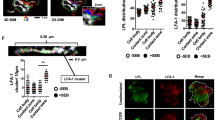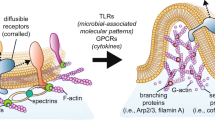Summary
The distribution and dynamics of LFA-1 molecules over the surface of human lymphocytes were analysed using immunogold label-fracture and fracture-flip methods. Patching and capping were induced by incubation at 37°C with antibodies directed against the alpha and beta chains respectively of the heterodimeric LFA-1 molecule, and were followed by immunofluorescence. Treatment with 12-O-tetradecanoylphorbol-13-acetate (TPA) to link LFA-1 molecules to the cytoskeleton increased the percentage of capped cells, implying a faster and more efficient process of capping. At all times of clustering or upon phorbol ester treatment, the concentration of LFA-1 in patches and then in caps was not accompained by a parallel concentration of membrane particles on the freeze-fractured plasma membranes. Our results support the role of the cytoskeleton in regulating the capping phenomenon and in controlling the structural organization of the plasma membranes.
Similar content being viewed by others
References
Andersson Forsman C, Pinto da Silva P (1988) Fracture-flip: new high-resolution images of cell surfaces after carbon stabilization of freeze-fractured membranes. J Cell Sci 90:531–541
Bourguignon LYW, Bourguignon GJ (1984) Capping and the cytoskeleton. Int Rev Cytol 87:195–224
Burn P, Kupfer A, Singer SJ (1988) Dynamic membrane-cytoskeletal interactions: specific association of integrin and talin arises in vivo after phorbol ester treatment of peripheral blood lymphocytes. Proc Natl Acad Sci USA 85:497–501
Elgsaeter A, Branton D (1974) Intramembrane particle aggregation in erythrocyte ghosts. J Cell Biol 63:1018–1030
Fougerolles AR de, Springer TA (1992) Intercellular adhesion molecule 3, a third adhesion counter-receptor for lymphocyte function-associated molecule 1 on resting lymphocytes. J Exp Med 175:185–190
Hynes RO (1992) Integrins: versatility, modulation, and signaling in cell adhesion. Cell 69:11–25
Kammer GM, Smith JA, Mitchell R (1983) Capping of human T cell specific determinants: kinetics of capping and receptor re-expressing and regulation by the cytoskeleton. J Immunol 130:38–44
Kupfer A, Singer SJ (1989) The specific interaction of helper T cells and antigen-presenting B cells. J Exp Med 170:1697–1713
O'Rourke AM, Mescher MF (1990) T-cell receptor-activated adhesion systems. Curr Opin Cell Biol 2:888–893
Otteskog P, Wanger L, Sundqvist KG (1983) Cytochalasins distinguish by their action resting human T lymphocytes from activated T-cell blasts. Exp Cell Res 144:443–454
Pardi R, Bender JR, Dettori C, Giannazza E, Engleman EG (1989) Heterogeneous distribution and transmembrane signaling properties of lymphocyte function-associated antigens (LFA-1) in human lymphocyte subsets. J Immunol 143:3157–3166
Pardi R, Inverardi L, Rugarli C, Bender JR (1992) Antigen-receptor complex stimulation triggers protein kinase C-dependent CD11a/CD18-cytoskeleton association in T lymphocytes. J Cell Biol 116:1211–1220
Pavan P, Mancini P, Frati L, Torrisi MR, Pinto da Silva P (1989a) Molecular cytochemistry of CD3 and CD4 antigens in human lymphocytes as studied by label-fracture and by fracture-label. Biochim Biophys Acta 978:158–168
Pavan A, Mancini P, Cirone M, Frati L, Torrisi MR, Pinto da Silva P (1989b) Capping of HLA antigens in human lymphocytes as followed by immunogold label-fracture. J Histochem Cytochem 37:1489–1496
Pavan A, Mancini P, Lucania G, Frati L, Torrisi MR (1990) High-resolution surface views of human lymphocytes during capping of CD4 and HLA antigens as revealed by immunogold fracture-flip. J Cell Sci 96:151–157
Pavan A, Covelli E, Pascale MC, Lucania G, Bonatti S, Pinto da Silva P, Torrisi MR (1992) Dynamics of transmembrane proteins during Sindbis virus budding. J Cell Sci 102:55–62
Pinto da Silva P, Kan FWK (1984) Label-fracture: a method for high resolution labeling of cell surfaces. J Cell Biol 99:1156–1161
Singer SJ (1992) Intercellular communication and cell-cell adhesion. Science 255:1671–1677
Slot JW, Geuze HJ (1981) Sizing of protein A-colloidal gold probes from immunoelectron microscopy. J Cell Biol 90:533–536
Springer TA (1990) Adhesion receptors of the immune system. Nature 346:425–434
Ursitti JA, Pumplin DW, Bloch RJ (1991) Ultrastructure of the human erythrocyte cytoskeleton and its attachment to the membrane. Cell Motil Cytoskel 19:227–243
Author information
Authors and Affiliations
Rights and permissions
About this article
Cite this article
Pavan, A., Lucania, G., Sansolini, T. et al. Patching and capping of LFA-1 molecules on human lymphocytes. Histochemistry 98, 253–258 (1992). https://doi.org/10.1007/BF00271039
Accepted:
Issue Date:
DOI: https://doi.org/10.1007/BF00271039




